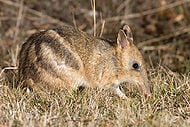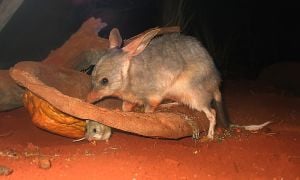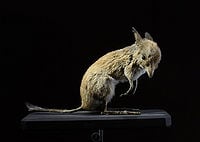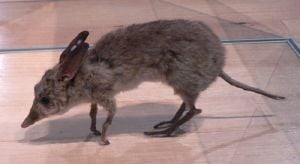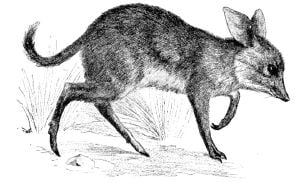Peramelemorphia
| Peramelemorphia
| ||||||||||||
|---|---|---|---|---|---|---|---|---|---|---|---|---|
 A short-nosed bandicoot (Isoodon spp.)
| ||||||||||||
| Scientific classification | ||||||||||||
| ||||||||||||
|
†Yaralidae |
Peramelemorphia is an order of marsupial mammals including the bandicoots and bilbies characterized by polyprotodont dentition (multiple lower incisor teeth as opposed to diprotodont dentition with two lower incisors) and syndactylous digits (with the second and third toes fused together while maintaining separate claws). There are two extant families in the order, Peramelidae (bandicoots and echymiperas) and Thylacomyidae (bilbies), with another modern family, Chaeropodidae (pig-footed bandicoots), now presumed to be extinct, although it was found into the 20th century. The extant species are ground-dwelling, rodent-like mammals characterized by elongate skulls with long, tapering snouts, a stocky body, and a marsupium that opens to the rear.
Peramelemorphs are found throughout Australia, New Guinea, and surrounding islands, including in Tasmania. There are about 22 extant species.
Bandicoots and bilbies play a vital role in the ecosystem, both in terms of food chains and control of insect pest populations. Omnivorous marsupials, peramelemorphs consume a variety of invertebrates (ants, termites, earthworms, spiders, centipedes, larvae) and plant matter (grasses, bulbs, seeds), as well as an occasional small vertebrate (lizards, mice, bird eggs). In turn, they are consumed by owls, dingos, quolls, and foxes, as well as feral and domestic cats and dogs. In addition to controlling insect pests, they may play a role in seed dispersal and the semifossorial bilbies may help aerate the soil through their burrowing. For humans, some are still hunted for food and fur and their unique nature adds to the joy of nature.
Physical description
All members of the order are polyprotodont. That is, they have several incisors in the lower jaw, as opposed to diprotodonts (kangaroos, possums, wallabies, koala, wombats, and others) which have only two lower incisors. In the case of Peramelemorphia, they have several lower incisors and anywhere from four to five upper incisors. These incisors are flattened at the tips (Frens 2011).
Peramelemorphs also are characterized by having the bones of the second and third toes of the hind limbs fused, yet maintaining separate claws (syndactyly).
Extant members of the order are characterized by a plump, arch-backed body, elongate skull with a long, delicately tapering snout, upright ears, short neck, thin but powerful and relative long hind limbs, short front limbs, and a thin and relative short tail (compared to body length), although the greater bilby has a long tail. The upright ears can vary from small and rounded to large and pointy. The fourth toe of the hind limbs is the largest. The first and fifth toes on the front feet are either absent or if present lack claws. The marsupium (the pouch where the immature young are carried) opens to the rear. Unlike other marsupials, bandicoots and bilbies have a chorioallantoic placental (which replaces the typical yolk sac placenta a few days into gestation; this type of placenta is found in placental mammals) and unlike the placenta of placental mammals, the peramelemorph placenta lacks villi (Frens 2011; Aplin et al. 2010).
Extant peramelemorphs range in body size from about 15 centimeters in length (excluding tail) and 100 grams in weight to 60 centimeters in length and 5 kilograms in weight. Most are rabbit-sized or smaller, such as the weight of a half-grown kitten (Frens 2011).
Distribution and habitat
All members of the order are terrestrial, ground-dwelling mammals endemic to the twin land masses of Australia-New Guinea. They are mainly in Australia, New Guinea, and the surrounding islands, although the eastern barred bandicoot and the southern brown bandicoot are found also in Tasmania (Frens 2011).
Bandicoots and bilbies occupy a large variety of habitats, ranging from deserts to grasslands to rainforests. For example, the greater bilby dwells in the desert while the brown bandicoots live in forests and the eastern barred bandicoots typically inhabit grassland areas. Thylacomyids (biblies) inhabit primarily arid areas. Some peramelemorphs can be found at 2000 meters in elevation (Frens 2011).
Behavior, reproduction, and diet
Bandicoots and bilbies are solitary and territorial, but male territories overlap with that of several females. A single female may give birth to as many as 16 offspring per year, with gestation ranging from about 12 days to 14 days (one of the shortest among mammals), and litters ranging from 2 to 5 altricial young. The newborns crawl into the pouch immediately after birth and remain there for about 60 days; the umbilical cord remains attached between the mother and offspring for a few hours after birth as a "safety rope" (Frens 2011).
The fossorial bilbies are the only peramelemorphs to dig their own burrows (other than some bandicoots constructing makeshift burrows to get out of hot weather). Peramelemorphs live about one to two years in the wild.
Bandicoots and bilbies are omnivorous and consume ants, insect larvae, termites, earthworms, spiders, centipedes, grasses and seeds, and bulbs, and some eat bird eggs, lizards, and mice. The main predators are owls, dingos, foxes, and quolls, as well as feral and domestic cats and dogs.
Phylogeny and classification
Placement within Marsupialia
The position of the Peramelemorphia within the marsupial family tree has long been puzzling and controversial. There are two morphological features in the order that appear to show a clear evolutionary link with another marsupial group: the type of foot (polyprotodont), and the teeth (syndactyly). Unfortunately, these clear signposts point in opposite directions (Gordon and Hulbert 1989). The polyprotodont characteristic suggests they evolved within Dasyuromorphia (marsupial carnivores), while the syndactyly condition is characteristic of the diprotodontia (the order of marsupial herbivores that includes kangaroos, wombats, possums, and many others) (Strahan 1995).
Attempts to resolve this puzzle include the view that the bandicoot group evolved from the carnivores, retaining the polyprotodont dentition, and independently evolving a syndactyl hind foot; the contrary view that syndactyly is so unusual that it is unlikely to have evolved twice and therefore the bandicoot group must have evolved from a possum-like diprotodont creature, and re-evolved its extra teeth. A third view suggests that the bandicoot group evolved from a primitive carnivore, developed the syndactylous hind foot as a specialization for climbing, and the diprotodonts then split off and evolved the two-tooth jaw that gives them their name. Recent molecular level investigations do not so far appear to have resolved the puzzle, but do strongly suggest that whatever the relationship of the bandicoot group to the other marsupial orders may be, it is a distant one (Meredith et al. 2008).
Relationships within Peramelemorphia
Recent molecular analyses have resulted in a phylogenetic reconstruction of the members of Peramelemorphia with quite strong support. The most basal split separates Thylacomyidae (bilbies, comprising the genus Macrotis) from all other bandicoots. Probably the next to diverge was the recently extinct Chaeropodidae (pig-footed bandicoot in genus Chaeropus). The remaining taxa comprise the Peramelidae, which divides into subfamilies Peramelinae (Isoodon and Perameles) and a clade in which the Echymiperinae (Echymipera and Microperoryctes) form a sister group to Peroryctinae (Peroryctes) (Meredith et al. 2008):
| Peramelemorphia |
| ||||||||||||||||||||||||||||||||||||
Classification
Early classification of Peramelemorphia divided the group into two families, with one family simply grouping the short-legged and mostly herbivorous bandicoots, and the other the longer-legged, nearly carnivorous bilbies.
However, the bandicoots of the New Guinean and far-northern Australian rainforests were deemed distinct from all other bandicoots and were for a time grouped together in the separate family Peroryctidae. This lead to a classification scheme where the extant bandicoots (and echymiperas), bilbies, and the pig-footed bandicoot being distributed into the two families of Peramelidae and Peroryctinae (ADW 2002a,b). The family Peramelidae included (1) the two bandicoot genera Perameles and Isodon, grouped together in the subfamily Peramelinae; (2) the bilbies (genus Macrotis) placed in the subfamily Thylacomyinae; and (3) the pig-footed bandicoot, which was either placed in Peramelinae, or placed together with the bilbies in the subfamily Chaeropodinae (ADW 2002). The second family Peroryctinae was used to group bandicoots in the four genera of Echymipera, Microperoryctes, Peroryctes, and Rhynchomeles.
Today, however, it is common to group the extant bandicoots, bilbys, and pig-footed bandicoot in their own families; respectively, Peramelidae (bandicoots and echymiperas), Thylacomyidae (bilbies), and Chaeropodidada (pig-footed bilby). Basically, the bandicoot families were reunited in Peramelidae, with the New Guinean species split into four genera in two subfamilies, Peroryctinae and Echymiperinae, while the "true bandicoots" occupy the subfamily Peramelinae. The only exception is the now extinct pig-footed bandicoot, which has been given its own family, Chaeropodidae. The bilbies have been placed in the family Thylacomyidae.
- Order Peramelemorphia
- Superfamily Perameloidea[1]
- Family Thylacomyidae
- Family †Chaeropodidae: Pig-footed bandicoot
- Genus †Chaeropus: 1 species
- Family Peramelidae
- Subfamily Peramelinae
- Genus Isoodon: short-nosed bandicoots
- Genus Perameles: long-nosed bandicoots
- Subfamily Peroryctinae
- Genus Peroryctes: New Guinean long-nosed bandicoots
- Subfamily Echymiperinae
- Genus Echymipera: New Guinean spiny bandicoots
- Genus Microperoryctes: New Guinean mouse bandicoots
- Genus Rhynchomeles: Ceram Bandicoot
- Subfamily Peramelinae
- Superfamily †Yaraloidea
- Family †Yaralidae
- Genus †Yarala: 2 species
- Family †Yaralidae
- Unclassified fossil bandicoots
- Superfamily Perameloidea[1]
Fossil record
Many specimens of modern peramelemorphian (e.g. Perameles spp. and Isoodon spp.) have been recovered in the fossil record from Pleistocene and Holocene fossil localities (Rich et al. 1991). However, very few fossil species have been recovered to date. The first species of fossil peramelemorphian was described by R. A. Stirton in 1955. The specimen Stirton described was a partial lower jaw from the Tirari Desert in Central Australia, Pliocene in age. The lower jaw morphology suggested a relationship with bilbies (Family Thylacomyidae), and was named Ischnodon australis (Stirton 1955).
It is not until 1976 that Archer and Wade described the next fossil bandicoot. A single upper molar was recovered from the Bluff Downs fossil site, Allingham Formation, in northern Queensland, also Pliocene in age. The tooth was similar to that of species of Perameles, hence why it was named Perameles allinghamensis (Archer and Wade 1976).
In 1995, the first Miocene species was described from Riversleigh, and was named Yarala burchfieldi by Dr Jeannette Muirhead. The species was represented by several upper and lower jaws, which were smaller than any living bandicoots and had a very primitive dentition (Muirhead and Filan 1995). A skull was later recovered in 2000, the first for any fossil peramelemorphian to date. Features of the skull and dentition suggested that Yarala burchfieldi was distinct from other peramelemorphians, and for this reason a new Superfamily Yaraloidea and Family Yaralidae were erected to classify this species (Muirhead 2000).
In 1997, Muirhead, Dawson, and Archer described a new species of Perameles, Perameles bowensis, from teeth recovered from two Pliocene fossil localities, Bow and Wellington Caves (Murihead et al. 1997). The same species was later reported in 2000 from Chinchilla, Queensland by Mackness and colleagues (Mackness et al. 2000). In 2002, Price described a new species Perameles, Perameles sobbei, from the Darling Downs (Pleistocene in age), south-eastern Queensland. This species was represented by a lower jaw and a few isolated lower molars (Price 2002). Additional material were later described in 2005 from the same site, including upper molars (Price 2005).
A second species of Yarala, Yarala kida, was described in 2006 by Schwartz. This species was recovered from Kangaroo Well, a late Oligocene site from the Northern Territory in Australia. This species is thought to be even more primitive than Yarala burchfieldi (Schwarz 2006).
The second fossil skull of any fossil peramelemorphian was also recovered from Miocene sites of Riversleigh. In fact, more than one skull of this new species was found (and several lower and upper jaws), and was significantly different from any other bandicoot to delineate a new genus, Galadi. The species was named Galadi speciosus by Travouillon and colleagues. It was short-snouted unlike modern bandicoots suggesting that it was more carnivorous than its omnivorous modern relatives. Its relationship to other bandicoots is unclear, but it was likely to be less primitive than Yarala but more primitive than living bandicoots (Travouillon et al. 2010). An additional three species of Galadi were later described in 2013 and named Galadi grandis, Galadi amplus, and Galadi adversus (Travouillon et al. 2013a).
Gurovich et al. (2013) described a new species of mouse-sized bandicoot from Riversleigh (Queensland) and Kutjamarpu (Southern Australia). The species, named Bulungu palara, is represented by a skull and several lower and upper jaws. Two other species in this genus were also described from the Etadunna Formation in South Australia, Bulungu muirheadae which is the oldest fossil bandicoot recovered to date (about 24 million years old), and Bulungu campbelli (Travouillon et al. 2013b).
Peramelidae
The family Peramelidae comprises peramelemorphians (members of the order Peramelemorphia) commonly known as bandicoots and echymiperas. (The common term bandicoot is also used for the pig-footed bandicoot in the family Chaeropodidae). The common name echymipera is often used interchangeably with bandicoot for members of the genus Echymipera; for example, Echymipera rufescens is commonly known as the long-nosed echymipera or the long-nosed bandicoot, and E. kalubu is variously known as the common echymipera or the common spiny bandicoot.
The 20 or so extamt species of small to medium-sized omnivores in this family are distributed into six genera: Isoodon, Perameles, Peroryctes, Echymipera, Microperoryctes, and Rhynchomeles.
Thylacomyidae
The family Thylacomyidae comprises peramelemorphians commonly known as bilbys. Before European colonisation of Australia, there were two extant species in one genus Macrotis. One species became extinct in the 1950s; the other survives but remains endangered. The extant species is known as the greater bilby (M. lagotis); the newly one extinct species is the lesser bilby (M. leucura). Two extinct genera also are recognized, each with their own species: Ischnodon australis (Stirton 1955) and Liyamayi dayi (Travouillion et al. 2014).
Bilbies have the characteristic long bandicoot muzzle and very long ears. Compared to bandicoots, they have a longer tail, bigger ears, and softer, silky fur. They are nocturnal omnivores that do not need to drink water, as they get all the moisture they need from their food, which includes insects and their larvae, seeds, spiders, bulbs, fruit, fungi, and very small animals. Most food is found by digging or scratching in the soil, and using their very long tongues.
Unlike bandicoots, they are excellent burrowers and build extensive tunnel systems with their strong forelimbs and well-developed claws. A bilby typically makes a number of burrows within its home range, up to about a dozen; and moves between them, using them for shelter both from predators and the heat of the day. The female bilby's pouch faces backwards, which prevents her pouch from getting filled with dirt while she is digging. Bilbies have a very short gestation period of about 12–14 days (Gordon 1984).
Bilbies are slowly becoming endangered because of habitat loss and change as well as the competition with other animals. There is a national recovery plan being developed for saving these animals: this program includes breeding in captivity, monitoring populations, and reestablishing bilbies where they once lived.
Chaeropodidae
The only identified species of the family Chaeropodidade, the pig-footed bandicoot (Chaeropus ecaudatus), was a peramelemorphia of the arid and semi-arid plains of Australia. The pig-footed bandicoot was native to western New South Wales and Victoria, the southern part of the Northern Territory as well as South Australia and Western Australia (Lydekker 1894). It inhabited a wide range of habitat types: from grassy woodland and grassland plains to the spinifex country and arid flats of central Australia. Despite its wide range, the species had a sparse distribution and was never abundant (Flannery and Schouten 2001). The distribution range of the species was later reduced to an inland desert region, where it was last recorded in the 1950s, and is now presumed to be extinct.
The pig-footed bandicoot had a body size of 23–26 cm and a 10–15 cm long tail. In form, it was almost bilby-like on first sight, having long, slender limbs; large, pointed ears; and a long tail. On closer examination, however, it became apparent that the pig-footed bandicoot was very unusual for a marsupial. The forefeet had two functional toes with hoof-like nails, rather similar to a pig or deer. The hind feet had an enlarged fourth toe with a heavy claw shaped like a tiny horse's hoof, with the other toes being vestigial:only the fused second and third toes being useful, and that not for locomotion but for grooming.
The pig-footed bandicoot had a broad head, and a long yet slender snout. Its fur was coarse and straight, but not spiny. In color it varied from grizzled grey through fawn to orange-brown, the belly and underparts were white with the fur on the ears being of chestnut color.
This species had five pairs of upper and three pairs of lower incision teeth. The females of the species had eight nipples and the opening of the pouch was faced backwards (Lydekker 1894; Harper 1945)).
It was a solitary, nocturnal animal that would sleep in its shelter during the day and emerge in the evening to feed, using its keen sense of smell to find food. Depending on the habitat, pig-footed bandicoots used a variety of shelters to hide from predators and for sleeping. In wooded areas and grasslands these ranged from hollow logs and nests made out of grass, while in arid treeless country this animal used to dig short, straight burrows with a nest at the end.
From surviving eyewitness reports and analyses of gut contents, dentition, and gut structure of museum specimens, it appears that the pig-footed bandicoot was the most herbivorous of bandicoots; although captive specimens were fond of meat and Aborigines reported that it ate grasshoppers, ants, and termites, the bulk of its diet was almost certainly leaves, roots and grasses. In captivity it was observed that they drank "a good deal of water" (Flannery and Schouten 2001).
According to Indigenous Australian oral tradition this species was rare even before the arrival of Europeans on the continent (Harpre 1945) and was in a serious decline even as it first came to scientific notice in the middle years of the 19th century. Two specimens of pig-footed bandicoot were obtained by local people in 1857 for Gerard Krefft, who accompanied the Blandowski Expedition. Despite the trouble taken in gaining living specimens, Krefft recorded his observations with an apology for eating one of them (Flannery 2001). Only a handful of specimens were collected through the second part of the 19th century, mostly from northwestern Victoria, but also from arid country in South Australia, Western Australia, and the Northern Territory. By the start of the 20th century, it had become extinct in Victoria and the south-west of Western Australia; the last certain specimen was collected in 1901. By 1945 the species vanished from South Australia and was reported to be limited to "a slight foothold in central Australia" (Harper 1945) Nevertheless, Aboriginal people report that it survived as late as the 1950s in the Gibson Desert and the Great Sandy Desert of Western Australia (Burbidge et al. 2008).
The cause of the extinction remains uncertain: neither of the two most destructive introduced exterminator species, the fox and the rabbit, had yet arrived in south-west Western Australia when the pig-footed bandicoot disappeared from that area. Feral cats were already common, which may offer an explanation; it is perhaps more likely that the decline was caused by a double habitat change. Firstly, the end of many thousands of years of Aboriginal burning which, being confined to a patchwork of small areas at any one time, had ensured both fresh new growth in the recently burnt areas and adjacent older growth for shelter and as a base for recolonization. However, Australia's Aboriginal population had declined by around 90% during the 19th century, largely because of the introduction of European diseases, and the remaining Aborigines were often no longer permitted to carry on their traditional land-management and hunting practices. Secondly, following on the heels of the near-extermination of the Aborigines, came the introduction of vast numbers of sheep and cattle, leading to significant changes in soil structure, plant growth, and food availability.
Notes
- ↑ R. Strahan, Mammals of Australia (Washington, D.C.: Smithsonian Institution Press, 1995). ISBN 1560986735.
- ↑ R. A. Stirton, "Late Tertiary Marsupials From South Australia," Records of the South Australian Museum 11(1955): 247-268.
- ↑ K. J. Travouillon, S. J. Hand, M. Archer, and K. H. Black, "Earliest Modern Bandicoot and Bilby (Marsupialia, Peramelidae and Thylacomyidae) From the Miocene of the Riversleigh World Heritage Area, Northwestern Queensland, Australia," Journal of Vertebrate Paleontology 34(2014):375-382.
- ↑ K. J. Travouillon, Y. Gurovich, R. M. D. Beck, and J. Muirhead, "An Exceptionally Well-preserved Short-snouted Bandicoot (Marsupialia; Peramelemorphia) from Riversleigh's Oligo-Miocene Deposits, Northwestern Queensland, Australia," Journal of Vertebrate Paleontology 30(issue 5)(2010): 1528–1546.
- ↑ K. J. Travouillon, Y. Gurovich, M. Archer, S. J. Hand, and J. Muirhead, "The Genus Galadi: Three New Bandicoots (Marsupialia, Peramelemorphia) From Riversleigh’s Miocene Deposits, Northwestern Queensland, Australia," Journal of Vertebrate Paleontology 33(issue 1)(2013): 153–168.
- ↑ Y. Gurovich, K. J. Travouillon, R. M. D. Beck, J. Muirhead, and M. Archer, "Biogeographical Implications of a New Mouse-sized Fossil Bandicoot (Marsupialia: Peramelemorphia) Occupying a Dasyurid-like Ecological Niche Across Australia," Journal of Systematic Palaeontology 12(issue 3)(2014): 265-290.
- ↑ K. J. Travouillon, R. M. D. Beck, S. J. Hand, and M. Archer, "The Oldest Fossil Record of Bandicoots (Marsupialia; Peramelemorphia) From the Late Oligocene of Australia," Palaeontologia Electronica 16(13A)(2013).
ReferencesISBN links support NWE through referral fees
- Animal Diversity Web (ADW). 2002. Peramelidae. Animal Diversity Web. Retrieved March 21, 2014.
- Animal Diversity Web (ADW). 2002b. Peroryctinae. Animal Diversity Web. Retrieved March 21, 2014.
- Aplin, K. P., K. M. Helgen, and D. P. Lunde. 2010. A review of Peroryctes broadbenti, the giant bandicoot of Papua New Guinea. American Museum Novitates 3696: 1-41.
- Archer, M., and M. Wade. 1976. Results of the Ray E. Lemley expeditions, part 1: The Allingham Formation and a new Pliocene vertebrate fauna from northern Queensland. Memoirs of the Queensland Museum 17: 54–58.
- Burbidge, A., C. Dickman, and K. Johnson. 2008. Chaeropus ecaudatus. In 2013 Red List of Threatened Species, version 2013.2. Retrieved March 21, 2014.
- Flannery, T. 2001. A lost menagerie. Natural History November 2001. Retrieved March 21, 2014.
- Flannery, T., and P. Schouten. 2001. A Gap in Nature. Atlantic Monthly Press. ISBN 0871137976.
- Frens, K. 2011. Peramelemorphia: Bandicoots and bilbies. Animal Diversity Web. Retrieved March 19, 2014.
- Gordon, G., and A. J. Hulbert. 1989. Peramelidae. Pages 603-624 in D. W. Walton (ed.), Fauna of Australia. Canberra: Australian Government Publishing Service.
- Gordon, G. 1984. Bandicoots. Pages 846-849 in D. Macdonald, The Encyclopedia of Mammals. New York: Facts on File. ISBN 0871968711.
- Gurovich, Y., K. J. Travouillon, R. M. D. Beck, J. Muirhead, and M. Archer. 2013. Biogeographical implications of a new mouse-sized fossil bandicoot (Marsupialia: Peramelemorphia) occupying a dasyurid-like ecological niche across Australia. Journal of Systematic Palaeontology 12(issue 3): 265-290.
- Lydekker, R. 1894. A Hand-book to the Marsupialia and Monotremata. London: W. H. Allen (Allen's Naturalist Library). Retrieved March 21, 2014.
- Harper, F. 1945. Extinct and Vanishing Mammals of the Old World. New York: American Committee for International Wild Life Protection. Retrieved March 21, 2014.
- Mackness, B. S., S. Wroe, J. Muirhead, C. Wilkinson, and D. Wilkinson. 2000. First fossil bandicoot from the Pliocene Chinchilla Local Fauna. Australian Mammalogy 22: 133– 136.
- Meredith, R. W., M. Westerman, and M. S. Springer. 2008. A timescale and phylogeny for "bandicoots" (Peramelemorphia: Marsupialia) based on the sequences for five nuclear genes. Molecular Phylogenetics and Evolution 47(issue 1): 1–20. PMID 18328736.
- Muirhead, J. 2000. Yaraloidea (Marsupialia, Peramelemorphia), a new superfamily of marsupial and a description and analysis of the cranium of the Miocene Yarala burchfieldi. Journal of Paleontology 74(3): 512-523.
- Muirhead, J., L. Dawson, and M. Archer. 1997. Perameles bowensis, a new species of Perameles (Peramelomorphia, Marsupialia) from Pliocene faunas of Bow and Wellington caves, New South Wales. Proceedings of the Linnean Society of New South Wales 17: 163–174.
- Muirhead, J., and S. L. Filan. 1995. Yarala burchfieldi, a plesiomorphic bandicoot (Marsupialia, Peramelemorphia) from Oligo-Miocene deposits of Riversleigh, northwestern Queensland. Journal of Paleontology 69(1): 127-134.
- Price, G. J. 2002. Perameles sobbei, sp. nov. (Marsupialia, Peramelidae), a Pleistocene bandicoot from the Darling Downs, south-eastern Queensland. Memoirs of the Queensland Museum 48: 193-197.
- Price, G. J. 2005. Fossil bandicoots (Marsupialia, Peramelidae) and environmental change during the Pleistocene on the Darling Downs, southeastern Queensland, Australia. Journal of Systematic Palaeontology 4: 347-356.
- Rich, T. H, M. Archer, S. J. Hand, H. Godthelp, J. Muirhead, N. S. Pledge, T. F. Flannery, et al. 1991. Australian Mesozoic and Tertiary terrestrial mammal localities, Appendix 1. Pp. 1005-1058 in P. Vickers-Rich, J. M. Monaghan, R. F. Baird, and T. H. Rich (eds), Vertebrate Palaeontology of Australia. Melbourne: Pioneer Design Studio and Monash University Publications Committee.
- Schwarz, L. R. S. 2006. A new species of bandicoot from the Oligocene of northern Australia and implications of bandicoots for correlating Australian Tertiary mammal faunas. Palaeontology 49: 991–998.
- Stirton, R. A. 1955. Late Tertiary marsupials from South Australia. Records of the South Australian Museum 11: 247–267.
- Strahan, R. 1995. Mammals of Australia. Washington, D.C.: Smithsonian Institution Press. ISBN 1560986735.
- Travouillon, K. J., Y. Gurovich, M. Archer, S. J. Hand, and J. Muirhead. 2013a. The genus Galadi: Three new bandicoots (Marsupialia, Peramelemorphia) from Riversleigh’s Miocene deposits, northwestern Queensland, Australia. Journal of Vertebrate Paleontology 33(1): 153–168.
- Travouillon, K. J., Y. Gurovich, R. M. D. Beck, and J. Muirhead. 2010. An exceptionally well-preserved short-snouted bandicoot (Marsupialia; Peramelemorphia) from Riversleigh's Oligo-Miocene deposits, northwestern Queensland, Australia. Journal of Vertebrate Paleontology 30(5): 1528–1546.
- Travouillon, K. J., R. M.. D. Beck, S. J. Hand, and M. Archer. 2013b. The oldest fossil record of bandicoots (Marsupialia; Peramelemorphia) from the late Oligocene of Australia. Palaeontologia Electronica 16, 13A.
- Travouillon, K. J., S. J. Hand, M. Archer, and K. H. Black. 2014. Earliest modern bandicoot and bilby (Marsupialia, Peramelidae and Thylacomyidae) from the Miocene of the Riversleigh World Heritage Area, northwestern Queensland, Australia. Journal of Vertebrate Paleontology 34:375-382.
| Mammals |
|---|
| Monotremata (platypus, echidnas) |
|
Marsupialia: | Paucituberculata (shrew opossums) | Didelphimorphia (opossums) | Microbiotheria | Notoryctemorphia (marsupial moles) | Dasyuromorphia (quolls and dunnarts) | Peramelemorphia (bilbies, bandicoots) | Diprotodontia (kangaroos and relatives) |
|
Placentalia: Cingulata (armadillos) | Pilosa (anteaters, sloths) | Afrosoricida (tenrecs, golden moles) | Macroscelidea (elephant shrews) | Tubulidentata (aardvark) | Hyracoidea (hyraxes) | Proboscidea (elephants) | Sirenia (dugongs, manatees) | Soricomorpha (shrews, moles) | Erinaceomorpha (hedgehogs and relatives) Chiroptera (bats) | Pholidota (pangolins)| Carnivora | Perissodactyla (odd-toed ungulates) | Artiodactyla (even-toed ungulates) | Cetacea (whales, dolphins) | Rodentia (rodents) | Lagomorpha (rabbits and relatives) | Scandentia (treeshrews) | Dermoptera (colugos) | Primates | |
Credits
New World Encyclopedia writers and editors rewrote and completed the Wikipedia article in accordance with New World Encyclopedia standards. This article abides by terms of the Creative Commons CC-by-sa 3.0 License (CC-by-sa), which may be used and disseminated with proper attribution. Credit is due under the terms of this license that can reference both the New World Encyclopedia contributors and the selfless volunteer contributors of the Wikimedia Foundation. To cite this article click here for a list of acceptable citing formats.The history of earlier contributions by wikipedians is accessible to researchers here:
The history of this article since it was imported to New World Encyclopedia:
Note: Some restrictions may apply to use of individual images which are separately licensed.
